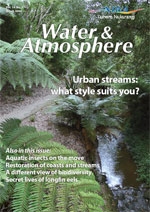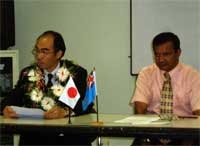PDF of this article (112 KB)

Mini-jaws: beware the carnivorous sponge

In February, NIWA hosted Professor Jean Vacelet, Director of Research at CNRS Centre d'Océanologie de Marseille, and the world’s foremost authority on deep-sea carnivorous sponges. He was here as a Visiting Scientist, working with Michelle Kelly on specimens collected as part of NIWA’s seamounts research.
In 1995, the exciting discovery of a carnivorous sponge in submarine caves in the Mediterranean Sea by Jean and colleagues changed the way we think about the phylum Porifera, as all sponges hitherto were known only to filter-feed. Since then, several more carnivorous species have come to light, but they are extremely rare and live in the deep ocean realm, usually accessible only by remotely operated vehicles or manned submersibles.
The members of this deep-sea family, the Cladorhizidae, display an unusual morphology; they are often very small and feather or dandelion-shaped, and often completely lack the filtering system characteristic of all other sponges. Hook-like spicules cover the outside of the sponge filaments, rather like sticky Velcro. These hooks passively capture tiny invertebrate prey, such as crustaceans, that brush against them. When the crustacean is stuck, the cells of the sponge stream toward the prey to engulf its flesh, digesting it within individual cells. The filaments contract as the cells migrate toward the meal; when the dinner is complete, the filaments grow and extend again for the next meal, a process that can take 3–8 days. This amazing form of feeding is novel among the Metazoa (multicellular organisms).
The carnivorous sponges in the NIWA collection were found principally near volcanic vents in the Bay of Plenty and on the Chatham Rise. Jean and Michelle have identified some 17 species of cladorhizid sponge, all of which are carnivorous. Only a single species was known from New Zealand before this work.
Jean considers the New Zealand fauna to be remarkably diverse compared to other parts of the world that he has studied. Early indications are that New Zealand deep-sea seamount environments harbour the greatest biological diversity of these species in the world. Perhaps, most importantly to New Zealand, this work adds considerable weight to the growing evidence that our seamounts are unique, harbouring an unprecedented biodiversity of unusual marine fauna.
For further information, contact: Dr Michelle Kelly, 0-9-375 2037, [email protected]
CenSeam: a global census of marine life on seamounts

The Census of Marine Life (CoML) is an international science research programme with the goal of assessing and explaining the diversity, distribution, and abundance of marine life – past, present, and future. CoML’s target for completion is 2010. CenSeam, a new CoML programme on seamounts, was established in 2005, and the secretariat is hosted by NIWA in Wellington.
Seamounts (undersea mountains) are prominent features of the world’s underwater topography. There are potentially up to 100,000 seamounts over 1 km high, and many more of lesser elevation. Seamounts can support high biodiversity and special biological communities, with high levels of endemic species (those found nowhere else).
Seamounts may play an important role in patterns of marine biogeography. They can be highly productive ecosystems, and act as feeding grounds for fishes, marine mammals, and seabirds. Seamount systems are economically valuable: they are the target of offshore commercial fishing and of potential interest for seabed mining. However, their biodiversity is poorly known. Relatively few seamounts have been studied; only about 350 have been sampled and fewer than 100 have been examined in any detail.
CenSeam will provide a framework to prioritise, integrate, expand, and facilitate seamount research. The aim is to build towards a global understanding of seamount ecosystems and the roles they play in the biogeography, biodiversity, productivity, and evolution of marine organisms.
CenSeam will coordinate existing and planned programmes to catalyse new seamount sampling, align and standardise research approaches and data collection, and facilitate comparisons of biodiversity between areas. The programme’s global perspective will help guide future sampling to fill critical gaps and target understudied regions and types of seamounts. CenSeam will also consolidate and synthesise existing data.
By 2010, much will remain unknown about seamounts, given the large number, their wide distribution, and large variability in physical characteristics and habitat type. But, with CenSeam, much progress can be made to improve our understanding of seamounts.
For further information, go to censeam.niwa.co.nz or contact: Dr Mireille Consalvey, 0-4-386 0853, [email protected]
